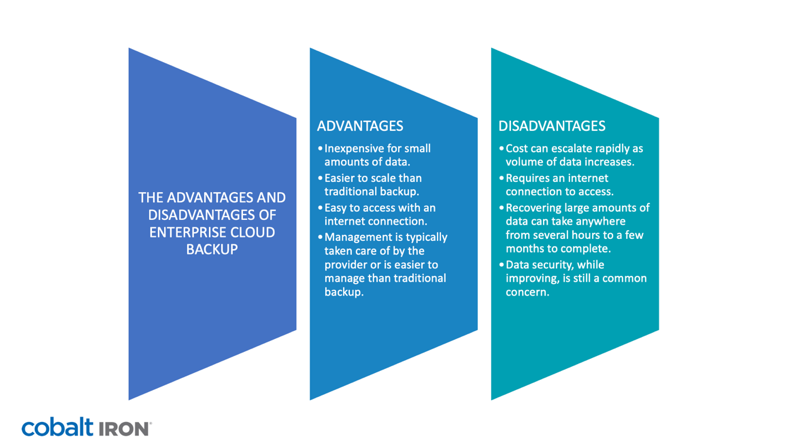
Anyone who’s responsible for enterprise data backup knows the pain. You absolutely need data protection, but the operational complexities and costs are becoming less and less tolerable. Though it might seem like there’s no end in sight to the madness of enterprise backup, and you wonder why you ever got into this business in the first place, I’m here to tell you that there’s hope. Read on.
The Good News
Thankfully, there is a tremendous amount of competition and investment in the enterprise backup market. So if you continue to struggle with significant challenges in efficiently protecting your large organization’s data assets, then you’re in luck.
Those significant challenges, combined with healthy competition and investment, are driving innovation and technology advancements that influence backup. Some of the many advancements include flash storage, snapshotting technologies, cloud services for various use cases, hyperconverged solutions, data reuse techniques, scale-out capabilities, the emergence of automation and analytics, and as-a-service delivery — each of which has its own value and advantages.
That’s the good news.
The Bad News
The bad news is that, despite all that advancement and investment, companies like yours are still fighting an uphill battle with enterprise backup.
You know the realities:
Most vendors continue to push a product-oriented approach, which tends to focus more on feature/function battles and marketing wars than on solving your problems. Sadly, many companies continue to accept products rather than solutions.
The value of enterprise cloud backup has yet to be effectively realized.
Most businesses find it hard to efficiently link legacy environments and operations with cloud services. In addition, most legacy backup products have piecemeal and immature deployment support for the cloud. At the same time, cloud-at-all-costs strategies don’t consider the fact that enterprise cloud backup is neither trouble-free nor cost-free. New, completely cloud-native products might not account for or adequately handle the massive scalability, performance, and security requirements of large-enterprise data-center workloads.
Cloud ResponsiblyTM
Without proper cloud architecture, cloud operations, and continual cloud monitoring, cloud costs can explode for a major enterprise application such as backup. One company recently was surprised to see its monthly cloud costs jump from $60,000 per month to $105,000 per month just trying to implement basic DR operations.
Another company had a robust enterprise cloud backup system but still relied on outdated legacy solutions for a variety of backup tasks. After updating its system to a more refined solution, overall efficiency was improved by 96%, and system backup times were reduced from several hours to only 15-20 minutes.
Cloud services are great tools but should be used when, where, and how they deliver the best value to the needs of the business. All this is to say that most cloud backup offerings haven’t quite risen to the level that would be efficient, affordable, and reliable enough for enterprise backup on their own. Instead, they should be used as a complement to more reliable platforms and solutions.
Overfunding in the enterprise backup market has led to new products but more bad experiences for backup custodians. Overpriced products are being pushed aggressively as the future of backup. Even these “easy to use” products can end up increasing overall operational complexities and being another silo of operational management. And legacy backup vendors will rightly challenge the maturity and scalability of the new players. Delivering true enterprise backup capabilities at petascale levels is not a task for the uninitiated.
In general, the enterprise backup market continues to try to solve complexity with complexity, leaving businesses to fend for themselves to:
- Understand and effectively leverage a continual flow of new technologies.
- Manage the operations and costs of a landscape of disconnected technologies.
- Manage aggressive data growth.
- Deliver data service levels efficiently to their business.
- Secure company data assets.
- Keep operational and capital expenses at a minimum, including managing the hidden costs of leveraging cloud for enterprise operations.
Amid the rush for technology advancement and new shiny objects, when will someone focus on actually solving the end-to-end operational complexities and costs of enterprise data protection, rather than just temporarily addressing them with product-pushing? There must be a better future for enterprise data protection.
That leads me to the best news of all.
The Great News
The real revolution in the backup market is occurring with the transformation of how end-to-end enterprise data protection is delivered and experienced. True solutions are emerging that deliver backup in more of a service or utility consumption model. With this model, infrastructure management and operations are replaced with automation. Costs become more consumption-based. Company data custodians can focus more on business requirements and opportunities than on mundane tasks. And backup analytics are even emerging that enable backup infrastructure and operations to self-optimize.
How can this solution be implemented?
Cobalt Iron is one of the pioneers of this transformation. Cobalt Iron’s Compass delivers automated, secure, analytics-optimized, hybrid-cloud, enterprise backup as a service. But it’s more than data protection-as-a-service; it’s data protection-as-a-solution that:
- Uses best-of-breed technologies, including cloud, to support your business goals.
- Automatically manages technologies, operations, and costs across the entire enterprise.
- Predicts and seamlessly fulfills growth and scalability needs.
- Automatically manages and monitors data service levels for backup, backup performance, data retention, and data availability for restore.
- Locks down, air-gaps, and contains company backup data assets.
- Minimizes operational and capital expenses, including efficient use of cloud as desired.
If you would like to learn more about improving your data protection and enterprise backup, you can contact Cobalt Iron here.
To learn more about traditional versus cloud-based backup solutions, read our blog post: Addressing vs. Solving – do you know the difference?
Come experience the future of enterprise data protection today with Compass.
< Back to Blog